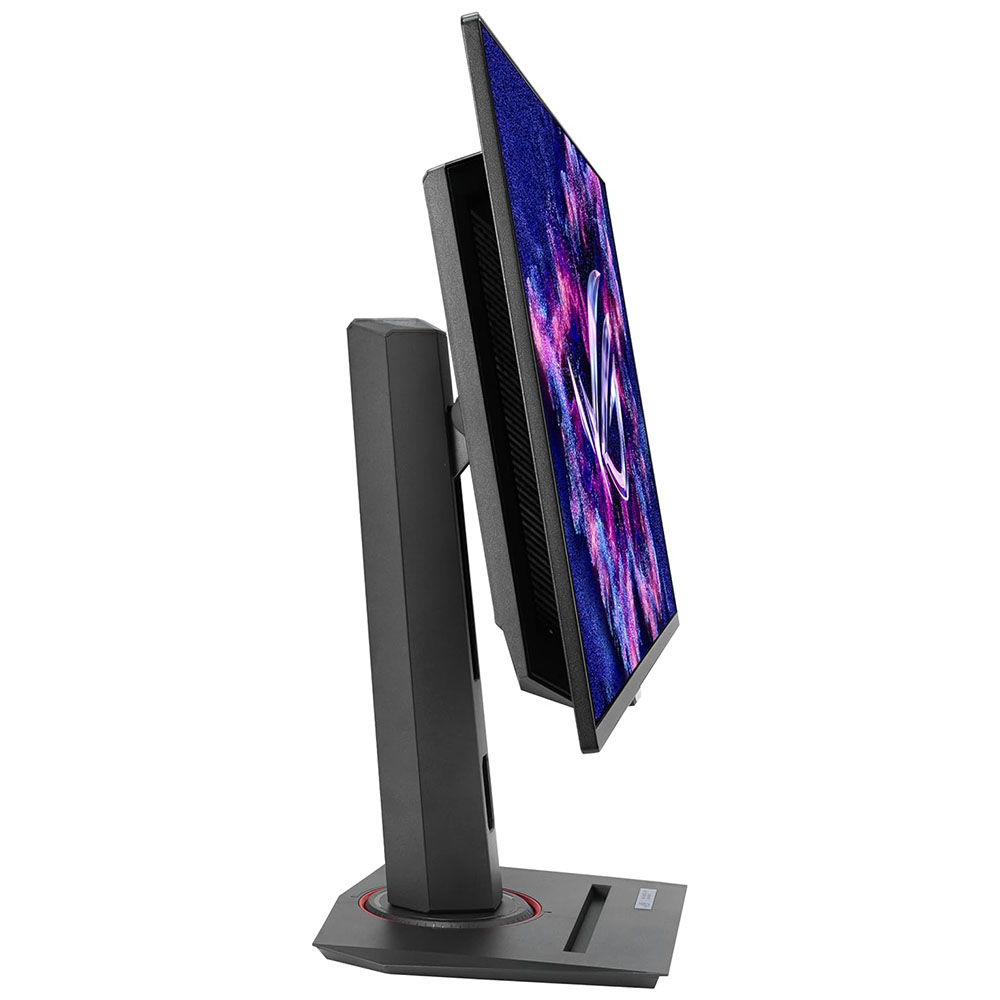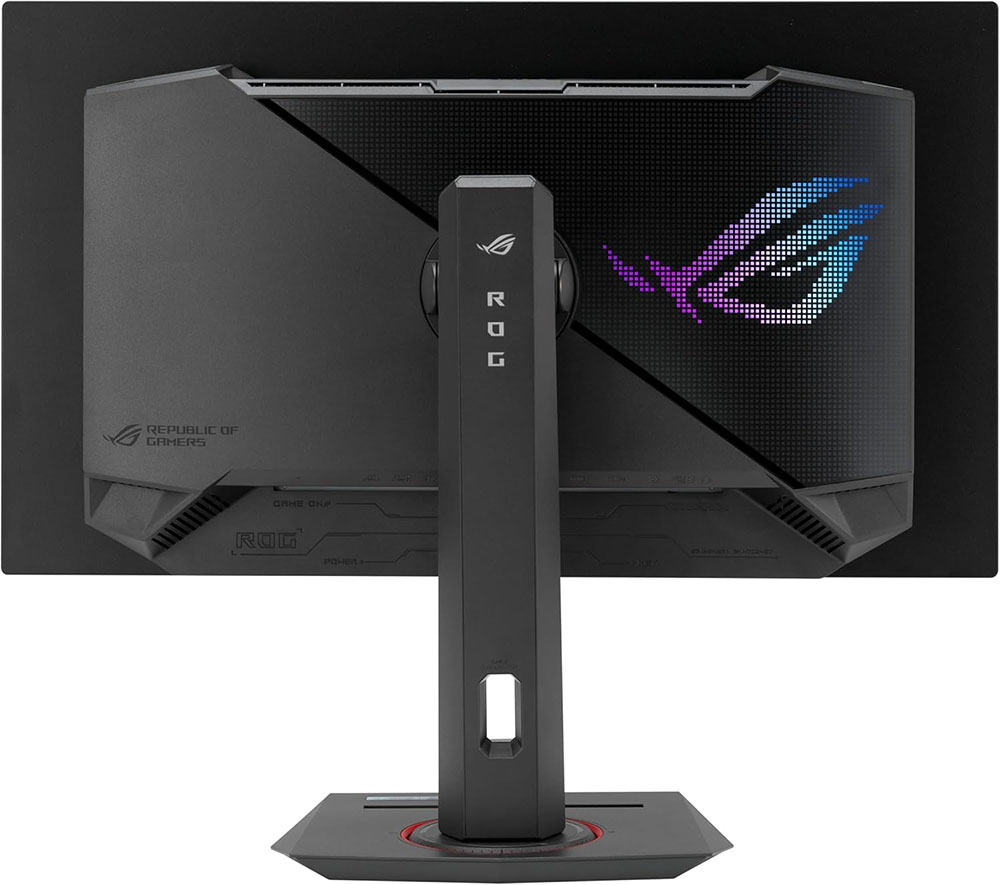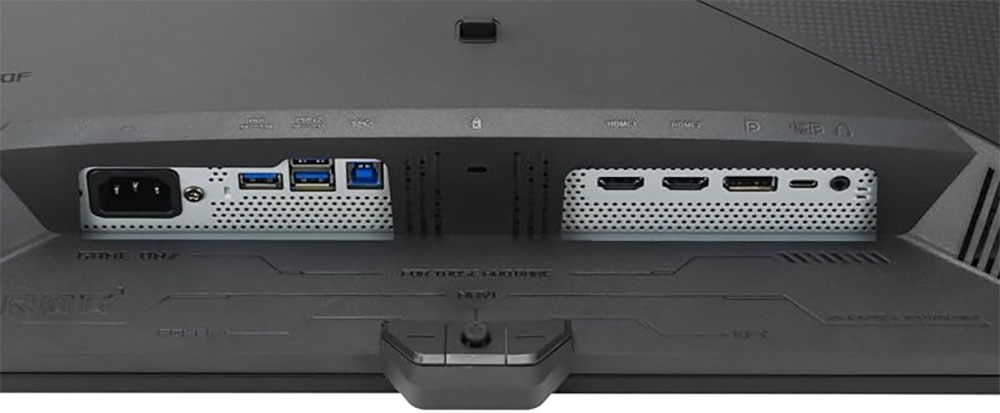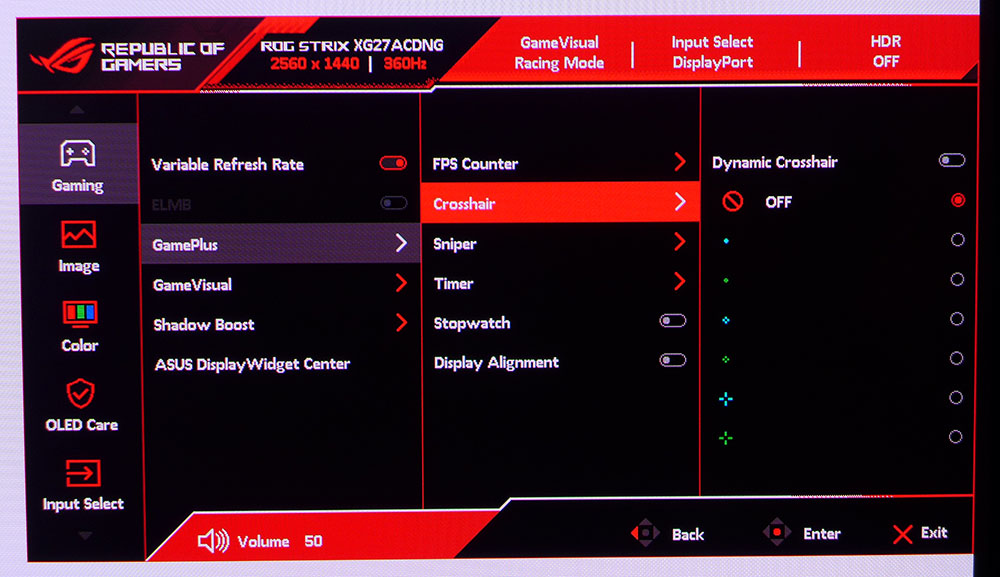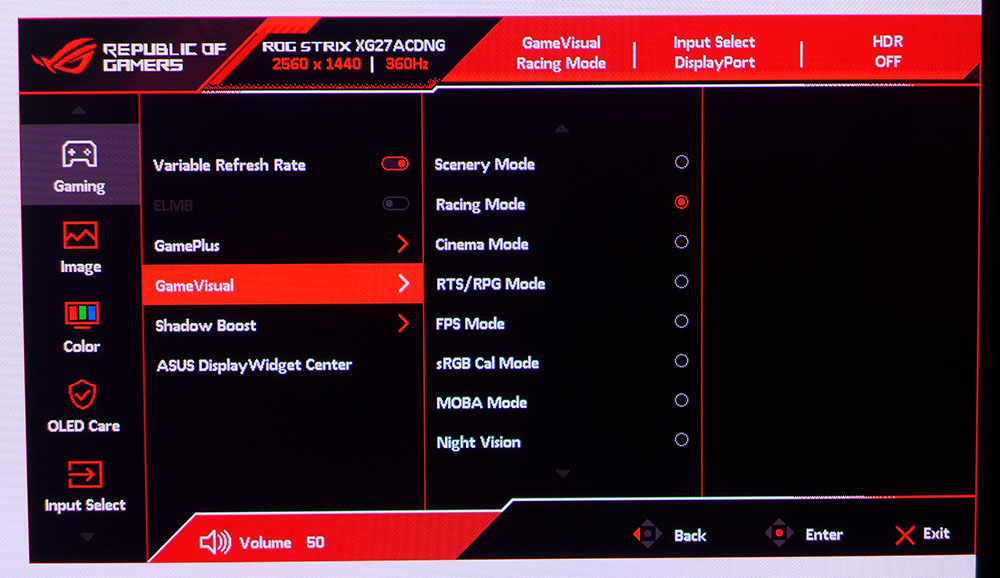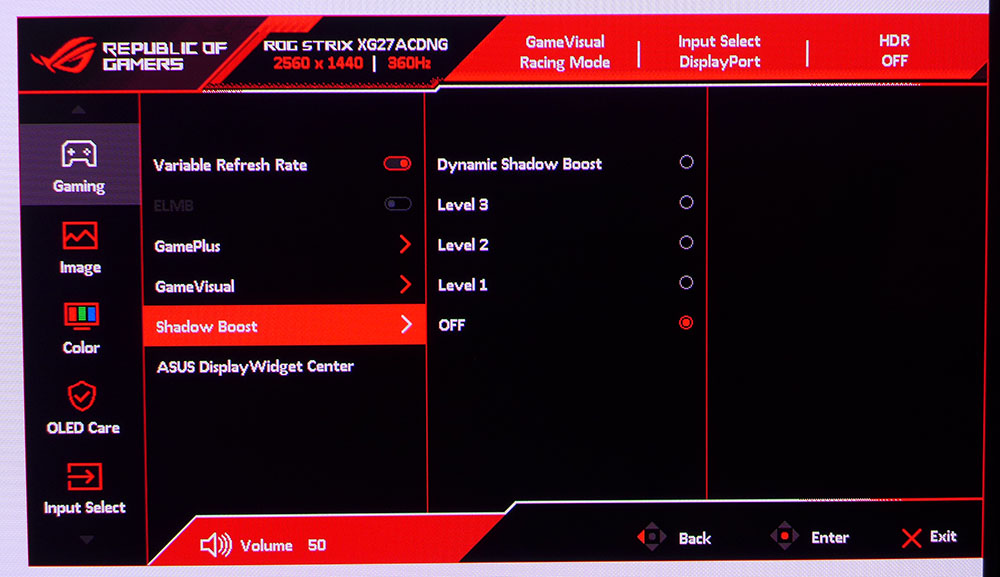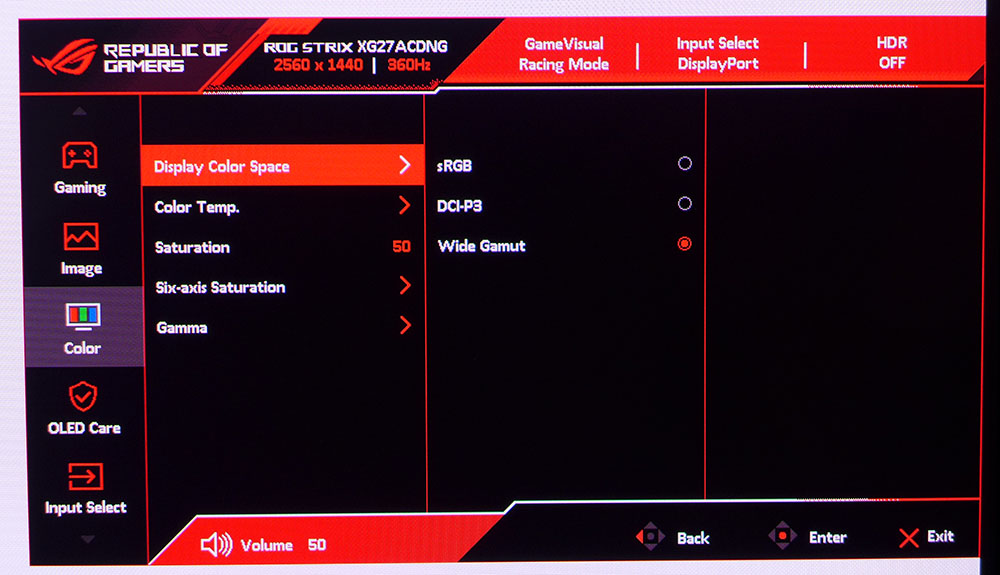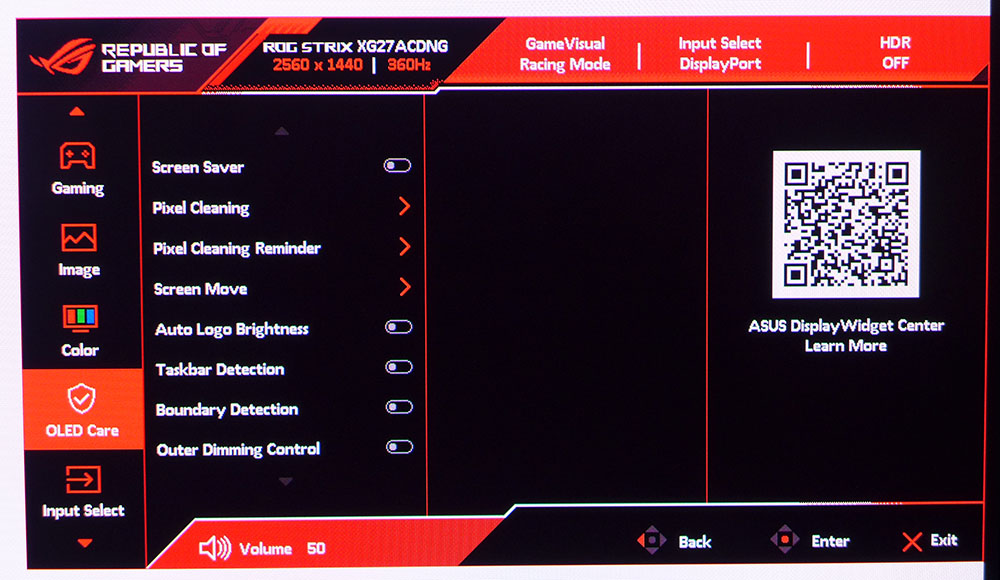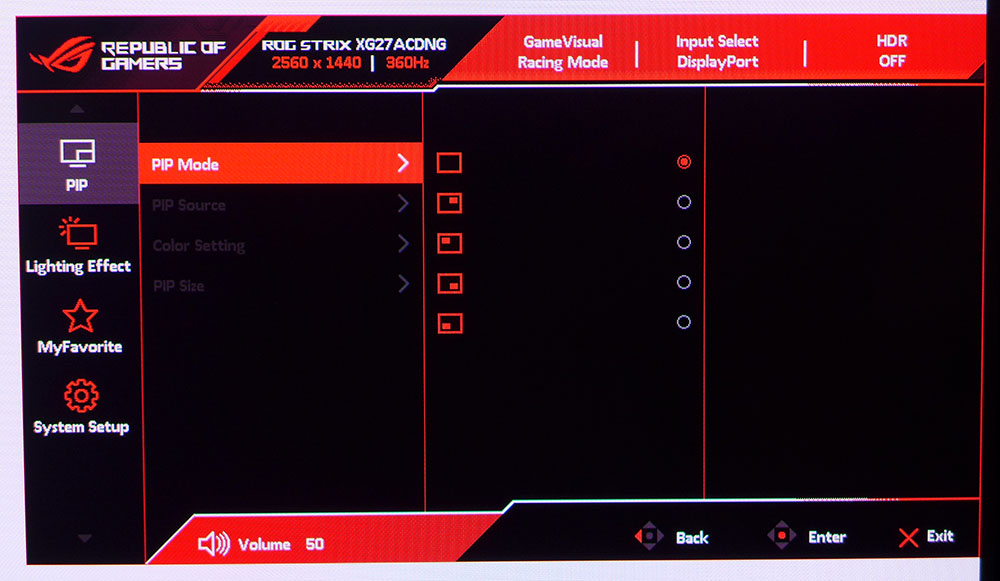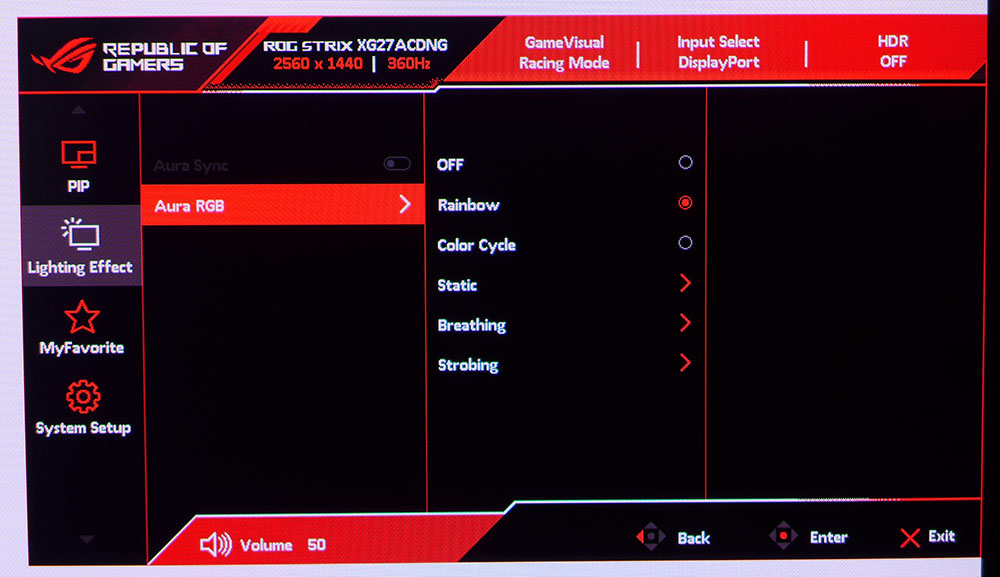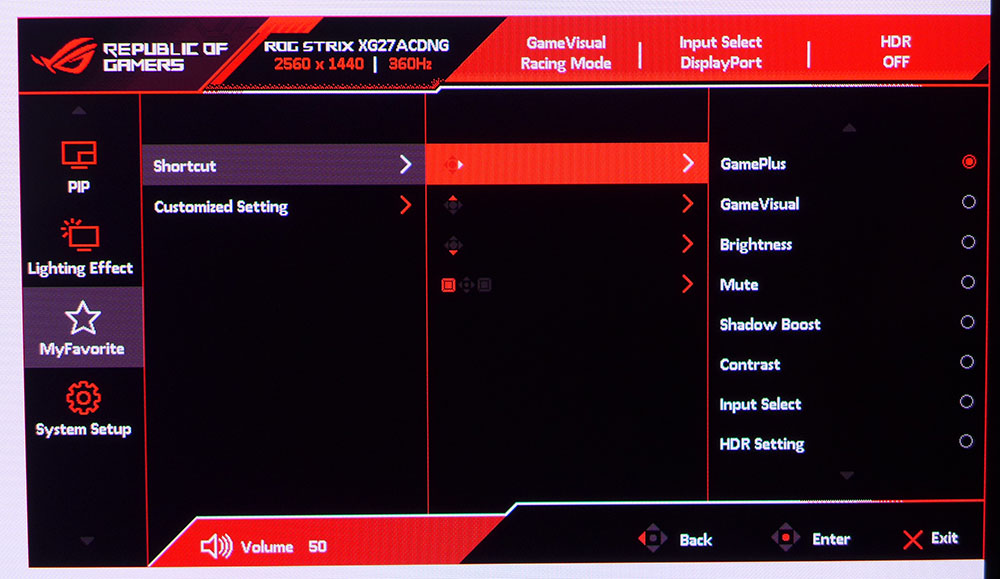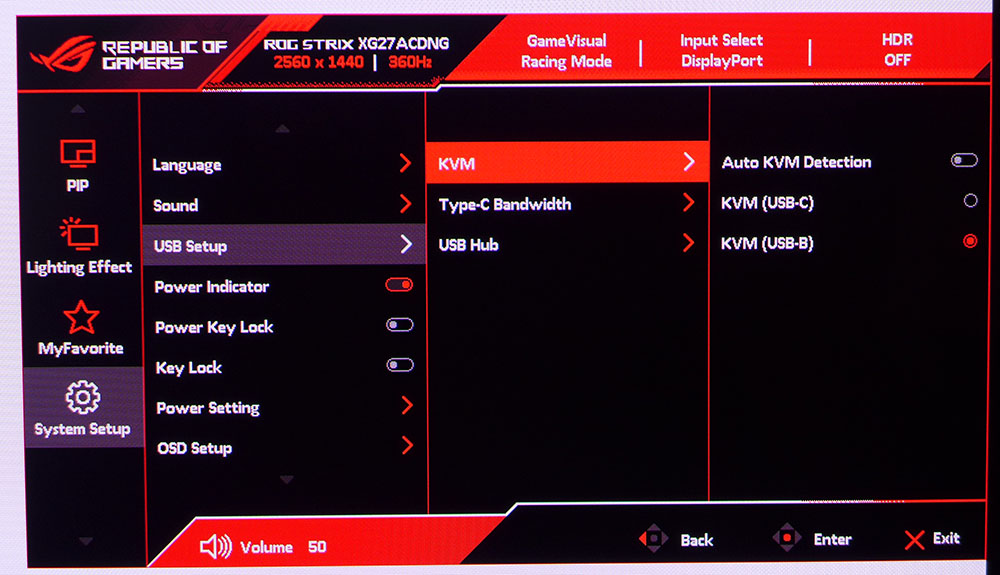If you’re looking for value in a high-performance gaming monitor, check out Asus’ ROG Strix line. These monitors typically offer near or the same performance as the more expensive Swift screens and can save you a few bucks. You still get the same rugged build quality and check-this-out styling, with slick LED lighting and glowing ROG logos.
The newest example I’ve encountered is the XG27ACDNG. This mouthful of letters describes a 27-inch Quantum Dot OLED running at QHD 2560×1440 resolution, with a 360 Hz refresh rate, Adaptive-Sync, HDR400, and a wide color gamut that fully earns the moniker “reference level.” Let’s take a look at what is one of the best gaming monitors currently available.
Asus ROG Strix XG27ACDNG Specs
Panel Type / Backlight | Quantum Dot Light Emitting Diode (QD-OLED) |
Screen Size / Aspect Ratio | 27 inches / 16:9 |
Max Resolution and Refresh Rate | 2560×1440 @ 360 Hz |
| Row 3 – Cell 0 | Accepts 3840×2160 @ 120Hz |
| Row 4 – Cell 0 | FreeSync and G-Sync Compatible |
Native Color Depth and Gamut | 10-bit / DCI-P3+ |
| Row 6 – Cell 0 | HDR10, DisplayHDR 400 |
Response Time (GTG) | 0.03ms |
Brightness (mfr) | 250 nits full field |
| Row 9 – Cell 0 | 450 nits 25% window |
| Row 10 – Cell 0 | 1,000 3% window |
Contrast | Unmeasurable |
Speakers | None |
Video Inputs | 1x DisplayPort 1.4 |
| Row 14 – Cell 0 | 2x HDMI 2.1, 1x USB-C |
Audio | 3.5mm headphone output |
USB 3.2 | 1x up, 3x down |
Power Consumption | 39w, brightness @ 200 nits |
Panel Dimensions WxHxD w/base | 24 x 15.5-20 x 8.6 inches (610 x 394-508 x 218mm) |
Panel Thickness | 2.8 inches (71mm) |
Bezel Width | Top: 0.31 inch (8mm) |
| Row 21 – Cell 0 | Sides: 0.43 inch (11mm) |
| Row 22 – Cell 0 | Bottom: 0.55 inch (14mm) |
Weight | 16.4 pounds (7.44kg) |
Warranty | 3 years |
If you want maximum color in any display, Quantum Dots should be on your checklist. This technology increases the coverage of OLED panels to around 110% of DCI-P3. The XG27ACDNG is the first example I’ve measured at over 111%. That color is also incredibly accurate. Asus calibrates each one before shipping and includes a data sheet in the box. My review sample measured so well that I could make no improvement. It nailed every number for gamma, color temp, and gamut. And it delivered this goodness in both SDR and HDR modes.
The XG27ACDNG supports HDR10 and has a VESA DisplayHDR 400 TrueBlack certification. With the Uniform Brightness feature turned off, I saw around 260 nits for a full white field pattern, 427 for a 25% window, and in HDR mode, a 3% window just cracked 1,000 nits. Coupled with the perfect black levels that OLEDs are known for, this means superlative contrast and an image depth unmatched by any other technology.
If you’ve read my past OLED reviews, you know that they are the best choice for high-performance gaming. The XG27ACDNG rises above the 240 Hz rank and file with a 360 Hz refresh rate and perfect video processing. Moving objects are just as crystal clear as static ones, and input lag is perceptually non-existent. Additional options include ELMB up to 180 Hz (instead of Adaptive-Sync) and OLED Anti-Flicker, which addresses the occasional stuttering one sees when using a variable refresh rate. It will also accept signals up to 3840×2160 pixels at 120 Hz.
The XG27ACDNG delivers all the visual appeal of an ROG display with futuristic styling and solid build quality. The back features LED lighting, and the front features a glowing logo to guide your hand to the OSD joystick and control keys. Asus also offers a Display Widget app that puts the OSD on the Windows desktop. You also get a rugged stand with a threaded mount at the top for mics and webcams. USB ports and a KVM function support peripherals.
The XG27ACDNG has everything you need to dominate your game world with a current street price of around $700. It doesn’t cut corners in any area and once you see the test results, you’ll want one.
Assembly and Accessories
I’ve seen a few Asus monitors packed in recyclable pulp, but the XG27ACDNG came in traditional crumbly foam. The panel snaps onto a two-part stand that assembles with a captive bolt. The accessory bundle comes in a nice, zippered bag and you get a slick VESA mount adapter for use with aftermarket arms. Cables include IEC power, two USBs, DisplayPort and HDMI. You also get a cleaning cloth and a sheet of ROG stickers to adorn your gaming PC.
Product 360
The XG27ACDNG puts most of its styling cues around the back. Up front, it’s all business. There’s a thin flush bezel and the bottom trim is quite narrow as well. A glowing ROG logo adorns a small protrusion in the center, which has an OSD joystick and two control keys behind it. The screen has a glossy outer layer, which isn’t too bad at rejecting reflection, but avoiding sunny windows is always a good idea with any OLED.
You can see a large ROG logo in the back made of dots and backlit. The LEDs can be controlled from the OSD and light up in any color with a selection of breathing, flashing or static effects. Smaller ROG graphics are on the beefy stand which has a small cable hole at the bottom. There’s 5/20 degrees tilt and 45-degree swivel along with 120mm of height adjustment and a 90-degree portrait mode. Movements are smooth and firm, with no play or wobble. At the top is a quarter-inch threaded socket for things like mics and webcams. The XG27ACDNG is a premium build in every way.
Other interesting bits include a phone slot in the base. It’s large enough to accommodate all but the biggest phones and hold them solidly. Just under the input panel are molded-in graphics to indicate different functions along with the mantra “For Those Who Dare.” You should dare to buy an XG27ACDNG because it’s awesome. Video inputs include two HDMI 2.1 and one DisplayPort 1.4. The USB-C port mimics DP functions. There are also USB-A and B ports, one upstream and three down, which are supported by a KVM feature in the OSD. A 3.5mm jack provides headphone audio. There are no internal speakers.
OSD Features
The XG27ACDNG has a packed OSD with every conceivable image and gaming option available. Pressing the joystick brings it up, and it’s divided into nine sections.
The fun starts with Gaming, and here you’ll find toggles for Variable Refresh Rate and ELMB. They can’t be used together and ELMB is only available at 180 Hz or below. It doesn’t include variable pulse width and it reduces brightness by around half. But it’s unnecessary because at 360 Hz with AS turned on, motion resolution is perfect. You would only consider using ELMB below 150fps.
This menu also has GamePlus which includes frame counters, aiming crosshairs with a dynamic option, sniper mode, timers and a stopwatch. The dynamic crosshair changes color on the fly to maintain contrast with the background. The picture modes are under the GameVisual heading and number nine in total. Racing is the default and best choice. It’s spot on in every metric and needs no adjustment. If you have trouble seeing in your game’s dark places, there are three shadow boost levels plus a dynamic option.
The Uniform Brightness option lives in the Image menu, with brightness and contrast and the four HDR modes. If it’s turned on, the peak white level is fixed at around 260 nits. Off, it jumps to 427 (25% window). You’ll have to change brightness to compensate, but I noticed that the XG27ACDNG retained separate values for each mode so once you’ve dialed it in, you can toggle Uniform Brightness off and on at will.
In the Color menu, you can choose between three color spaces. Wide Gamut is fine for everything but if you want sRGB, it’s here too. It is a better option than the sRGB Cal picture mode because it retains all adjustments. You also get fixed color temps with a user option and a selection of gamma presets.
OLED Care options are extensive and include compensation for logos, taskbars and graphical boundaries. You can turn on a pixel shift and run cleaning routines. It’s good to see this level of attention to detail but in my experience, there is no need for concern. I’ve been using an OLED monitor for almost a year now and it shows no signs of burn-in. It runs a cleaning routine every few days.
The XG27ACDNG has PIP and PBP options with the ability to view two video sources at once. For the LED lights in the back, Aura RGB includes five different effects and options for all colors. Aura Sync matches the light show to what’s happening on the screen.
Three of the joystick directions are programmable for quick access to often-used functions. You can also save your settings to two memories for later recall. Finally, you’ll find the KVM options in the System Setup menu where you can bind USB ports to video inputs for control of multiple systems with a single set of input devices.
Asus ROG Strix XG27ACDNG Calibration Settings
The XG27ACDNG does not require calibration in its Racing mode and I could not make any improvement when I tried. It’s that precise. The only choices one might make are brightness and color space. To set brightness, turn Uniform Brightness on, find your preferred light level, then repeat the process with UB turned off. The XG27ACDNG retains the brightness value for both scenarios, so you don’t have to readjust when switching back and forth. This is extremely handy. I’ve included commonly used output levels for both situations below.
When HDR signals are detected, the XG27ACDNG unlocks four new modes, all of which are reasonably accurate. TrueBlack is the best choice according to my measurements. If you want to tweak brightness and contrast, there’s a toggle that lets you do that.
Picture Mode | Racing |
Uniform Brightness | On / Off |
Brightness 200 nits | 80 / 44 |
Brightness 120 nits | 46 / 24 |
Brightness 100 nits | 37 / 19 |
Brightness 80 nits | 29 / 14 |
Brightness 50 nits | 17 / 7 (min. 12 / 22 nits) |
Contrast | 80 |
Gamma | 2.2 |
Color | 6500K |
Gaming and Hands-on
Though there isn’t much to setting video processing options on any OLED, it’s worth checking out the provided features, and the XG27ACDNG has a few. There’s no overdrive, but there is ELMB. It won’t work with Adaptive-Sync turned on and it maxes at 180 Hz. It has no artifacts, but brightness is reduced by half. There is no adjustment, it’s either on or off. If you have enough processing power to keep frame rates above 200fps, it’s better to stick with Adaptive-Sync. The XG27ACDNG proved compatible with both FreeSync and G-Sync in my tests.
A feature unique to Asus is OLED Flicker. Or more precisely, OLED Flicker compensation. This option has medium and high settings and helps in low frame rate situations when you might see a little stutter. If you stay above 200fps, you won’t need it. I noted that switching between HDR modes or toggling on OLED Flicker switched the XG27ACDNG out of HDR mode necessitating a trip to the game’s menu to turn it back on. If you can run over 200fps consistently, stick with Adaptive-Sync and OLED Flicker off. My GeForce RTX 4090 equipped PC managed numbers consistently above 320fps with detail maxed in Doom Eternal’s Horde Mode.
Gameplay was a premium experience with perfect resolution in moving objects and panned backgrounds. There was never any smearing or breakup. Though I’ve played on a few monitors with lower input lag, the XG27ACDNG isn’t far behind the very best and to my perception, it is as quick as anything else I’ve tested. If you’re coming from a slower monitor, you’ll need to adjust your perception a bit as it is very precise. Movements start and stop exactly where you intend with no delay. It’s hard to imagine a better display for any type of game, from casual to frenetic.
Since it can accept Ultra HD signals up to 120 Hz, I tried this option in Windows and while gaming. I do not recommend using 3840×2160 for everyday tasks. Since it is not a multiple of the native 2560×1440 pixels, clarity is significantly reduced. Small text is very hard to read. Gaming at this resolution drops the frame rate to 120fps, introducing visible blur. I returned to QHD signals for the remainder of the review.
The XG27ACDNG is a superb everyday monitor for anything you can do with a PC. The image is stunning in SDR and HDR mode making it a great tool for graphics work. Photoshop images are richly detailed with perfect color. sRGB mode is just a couple of clicks away when you need it. Watching video is always awesome on an OLED. Movement is smooth with gorgeous color and contrast.
Some users might be concerned about resolution, and indeed, there are 4K OLEDs available at higher cost. But consider this: contrast is so good that the picture looks sharp even at 109ppi pixel density. You’ll have to practically press your nose on the screen to see any dot structure. High contrast always delivers higher sharpness. And QHD means faster frame rates in your favorite games, and lower cost of entry.
Takeaway: The XG27ACDNG is pretty much flawless for gaming, video and productivity. 27-inch flat panels are an ideal size for footprint, pixel density and price. QHD resolution delivers high frame rates and the super quick response OLEDs are known for. I can’t imagine anyone regretting this purchase.
MORE: Best Gaming Monitors
MORE: How We Test PC Monitors
MORE: How to Buy a PC Monitor







